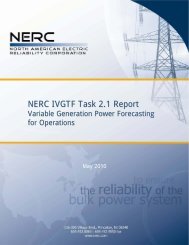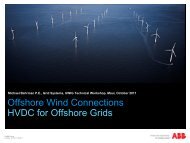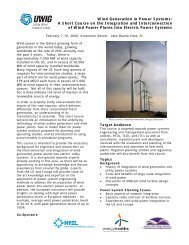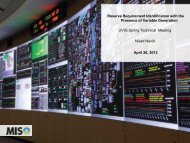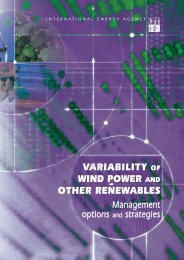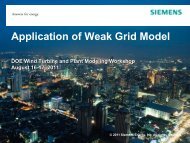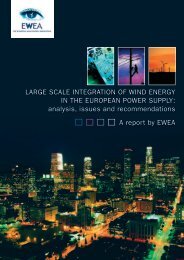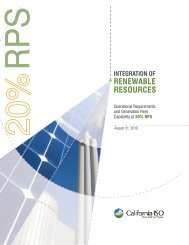Integrating Southwest Power Pool Wind to Southeast Electricity ...
Integrating Southwest Power Pool Wind to Southeast Electricity ...
Integrating Southwest Power Pool Wind to Southeast Electricity ...
Create successful ePaper yourself
Turn your PDF publications into a flip-book with our unique Google optimized e-Paper software.
2<br />
REPRESENTATION OF TRANSMISSION NETWORK<br />
FOR HIGH WIND CASES<br />
As noted in detail in the Task 1 Report, the transmission network included in the SCUC/SCED<br />
model for the Non-RES case was a slightly modified version of a model developed by SPP and<br />
Entergy (with input from Southern, TVA, et. al.) for a FERC filing. This modeled transmission<br />
network was planned <strong>to</strong> support only 7 GW of installed wind generation interconnected within<br />
SPP for consumption within SPP. As such, the transmission network in the non-RES model is<br />
not designed <strong>to</strong> support high wind transfers from SPP <strong>to</strong> SERC. Further, the primary focus of<br />
the DOE funded work is not <strong>to</strong> evaluate transmission investments for supporting such transfers,<br />
but rather <strong>to</strong> evaluate the balancing challenges associated with such high level of wind in SPP<br />
and the potential benefits of coordination among SPP and SERC BAs in addressing those<br />
balancing challenges. This section summarizes limited analysis of the capability of the modeled<br />
transmission network <strong>to</strong> deliver wind energy from wind plants located in the SPP region.<br />
Further, this section summarizes the modeling/simulation approach that was utilized <strong>to</strong> enable<br />
analysis of the balancing cooperation benefits for the high wind transfer cases despite the<br />
transmission delivery limitations and the implications of the associated assumptions.<br />
Transmission Delivery Limitations<br />
While the focus of the project was not <strong>to</strong> assess capability of the modeled transmission <strong>to</strong> deliver<br />
wind from SPP, a simplified analysis was conducted <strong>to</strong> obtain an idea of the limits. This analysis<br />
was based on including an additional 7 GW of wind in the Non-RES model in the SPP region for<br />
an aggregate SPP wind generation capacity of 14 GW with all other model parameters<br />
maintained as in the 7 GW Non-RES case. First, the 14 GW case SCUC/SCED simulation was<br />
conducted and compared <strong>to</strong> the 7 GW Non-RES case results <strong>to</strong> evaluate how much of the<br />
additional wind generation in SPP appears <strong>to</strong> flow <strong>to</strong> SERC BAs. Second, the transmission<br />
network in the 14 GW case was then modeled as being unconstrained – no thermal flow limits –<br />
<strong>to</strong> determine how much wind generation is being curtailed by the transmission thermal limits.<br />
Table 2-1 shows the changes in average generation per BA per generation type between the 14<br />
GW and 7 GW cases. The table shows the following general trends:<br />
The additional approximately 7 GW of wind capacity in SPP results in an additional average<br />
wind generation output of 2131 MW.<br />
The additional 2131 MW of wind in SPP is consumed as follows<br />
o increase in average system losses of 282MW<br />
o reduction in average external net generation of 791 MW<br />
o reduction in average SPP coal generation output of 794 MW<br />
• small reduction in average SERC generation, mostly impacting CC output<br />
Table 2-1<br />
2-1




